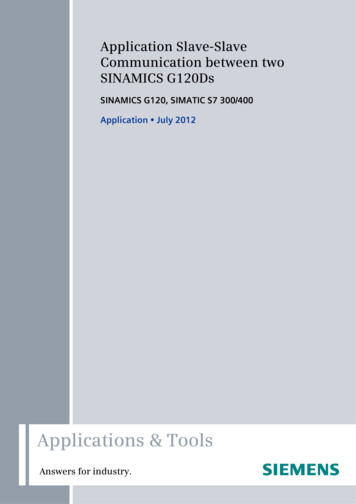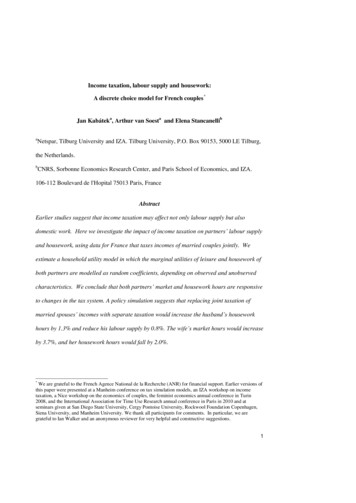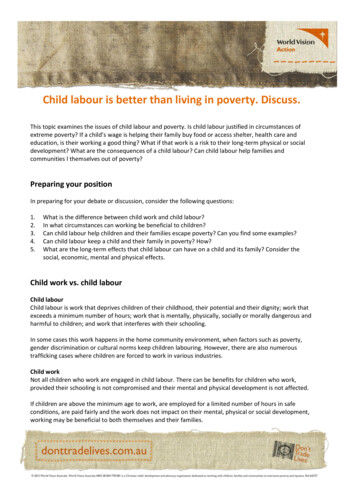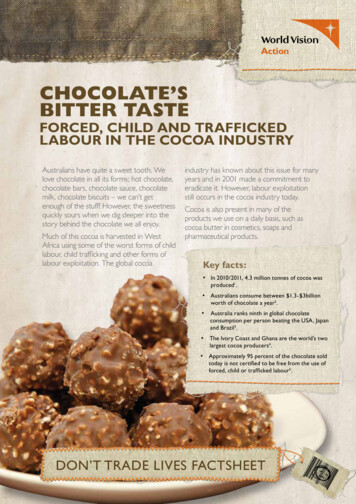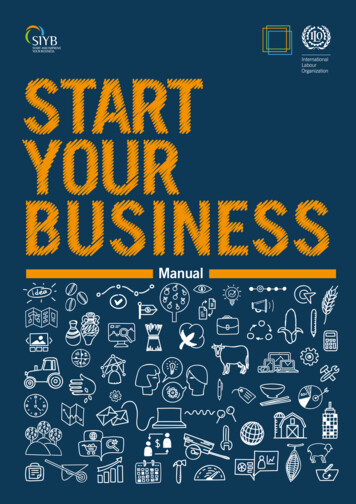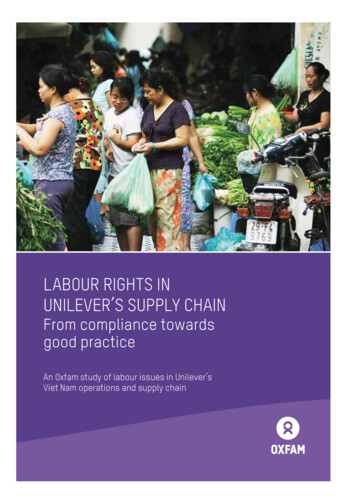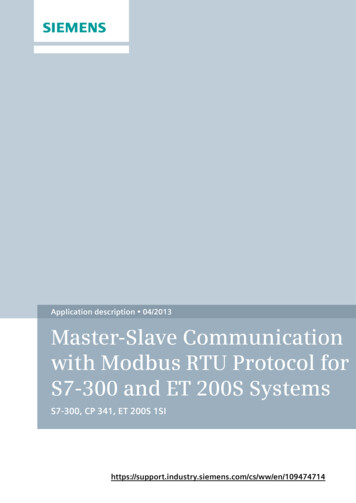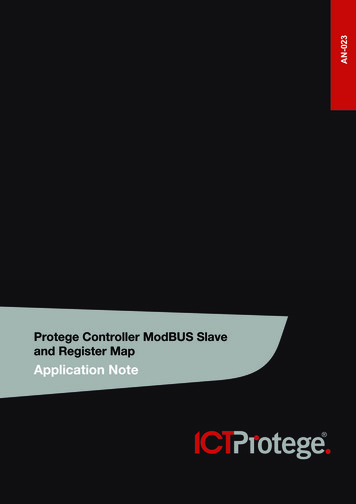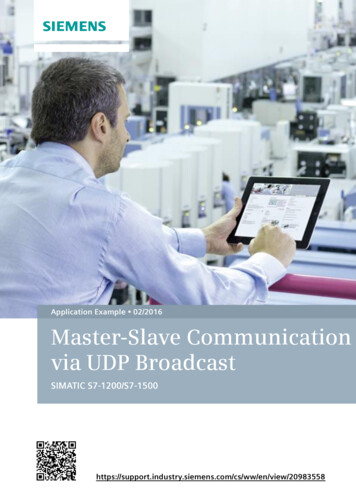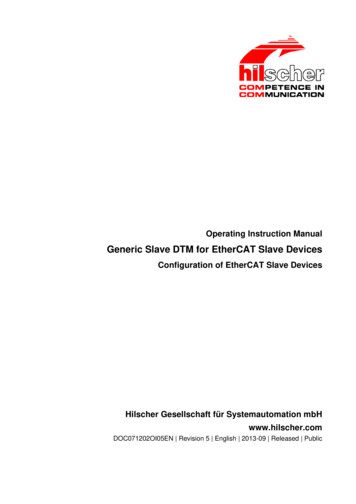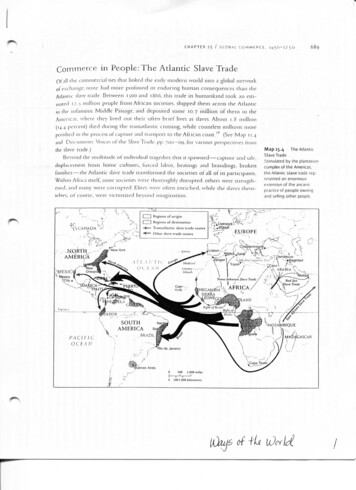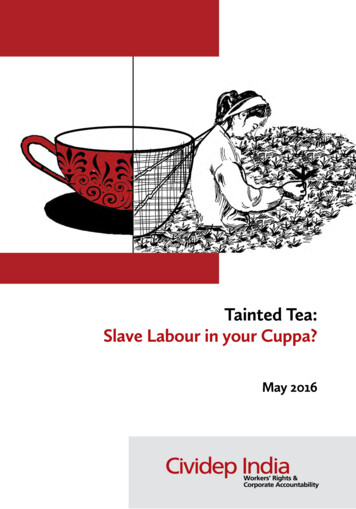
Transcription
Tainted Tea:Slave Labour in your Cuppa?May 2016
Author Pramita RayResearch Assistance Tamara HarmsenOverall Coordination Laura Ceresna-ChaturvediThis report has been produced with the support of The Norwegian Forum forDevelopment and Environment (ForUM).The Norwegian Forum for Development and Environment (ForUM) is anetwork of 50 Norwegian organizations within development, environment,peace and human rights. Our vision is a democratic and peaceful world basedon fair distribution, solidarity, human rights and sustainability.Cividep India is an NGO based in Bangalore, India, which works to ensure thatbusinesses comply with human rights, labour rights and environmental standards. With this objective, Cividep studies the effects of corporate activities oncommunities and the environment and educates workers about their rights.
ContentsList of Abbreviations 41. Introduction 52. The International Supply Chain for Tea83. Research Objectives and Methodology114. Violations of Workers’ Rights on Plantations in Assam124.1 Abysmal Wages 135. The Tea Auction System165.1. How Tea is Sold: The Role of Brokers165.2. The Guwahati Tea Auction Centre (GATC) Auction Process175.3. The 50%-50% Rule 185.4. The Role of the Indian Tea Board186. Exporters and Importers 197. International Blenders and Packers: Hindustan Unilever (HUL)217.1. Tea Labels and Retail 217.2. Certification 227.3. Responsible Sourcing and Compliance: The Unilever ResponsibleSourcing Policy (RSP)227.4. Do Unilever’s Words Hold Weight?268. Certification Schemes and Bodies278.1. Trustea 278.2. Rainforest Alliance 288.3. Fairtrade 298.4. The Ethical Tea Partnership (ETP)308.5. UTZ 319. Conclusion 32List of References 34Annex: Websites for the Tea Auction System 35
List of AbbreviationsACMS Assam Chah Mazdoor SanghaBLF Bought Leaf FactoryBBC British Broadcasting CorporationCCPA Consultative Committee of Plantation AssociationsETP Ethical Tea PartnershipFAO Food and Agriculture Organization of the United NationsFLO-CERT Fairtrade International’s Certification BodyGTAC Guwahati Tea Auction CentreHUL Hindustan UnileverIDH The Sustainable Trade InitiativeINGO International Non-Governmental OrganizationITA Indian Tea AssociationMNC Multinational CorporationNGO Non-Governmental OrganizationRSP Unilever Responsible Sourcing PolicySAN Sustainable Agriculture NetworkTCC Tropical Commodity CoalitionTGB Tata Global BeveragestAC trustea Advisory CommitteetPC trustea Program CommitteeTrustea India Sustainable Tea ProgrammeUK United KingdomUNICEF United Nations Children’s Emergency FundURSA Understanding Responsible Sourcing Audit (Unilever)USAC Unilever Sustainable Agriculture CodeUSLP Unilever Sustainable Living PlanUTZ Utz Kapeh4/274/36
1. INTRODUCTIONThe main objective of this study is to trace the Assam tea supply chain from the plantations to well-known retailers in the UK, which is a major consumer of Assam tea.Greater clarity on how the tea trade system works can provide fresh ideas on how toachieve greater transparency in the supply chain.At work: A typical plantation in Assam. Photo by Rajan Zaveri, NazdeekIn September 2015 a BBC investigation of working conditions on the tea estates ofAssam, many of which supply tea to popular labels in the UK, revealed deplorableconditions on several estates. Among them were plantations owned by the tea giantMcLeod Russel. Surprisingly, many of these were certified by recognized bodies like theRainforest Alliance.Workers live in abject poverty as a result of wages that are even lower than the statutory minimum wage in the state. They were found living in ramshackle houses on theestates that were in a state of utter disrepair. Walls were damp, ceilings leaked, therewas often no electricity, and the shared latrines nearby were clogged or broken andcompletely unusable. Workers were forced to defecate among tea bushes. Open drainsoverflowed into living areas.11 http://www.bbc.com/news/world-asia-india-34173532 Accessed 12/12/20155/36
Workers on their way to spray pesticide, but without personal protective equipment(PPE). Photo Courtesy of Accountability CounselOne plantation owned by the Assam Company was employing children below the ageof 15 years, while workers on a McLeod Russel-owned estate were found spraying chemical pesticides without proper protective equipment. Young children and infants areoften malnourished, and die of preventable diseases.The BBC team faced resistance from the estate management while trying to enter aplantation, even though it is legally permissible for members of the public to visit theareas where workers live. This is symptomatic of the opaqueness of the supply chain,which makes it difficult to hold companies selling irresponsibly sourced tea accountable. There is an immediate need to make the supply chain more transparent in orderto hold companies to account on the question of protecting human rights in theirsupply chains. Identifying pressure points will make it easier to assess where leverageexists, and to use it to effect positive change in the sector.Not only is transparency crucial for addressing human rights violations againstworkers, but it also benefits businesses in a number of ways. Investor confidencein a brand increases when its operations are transparent and open to publicscrutiny. As more consumers become conscientious about how products are sourcedand produced, prominent brands can no longer afford to ignore their social andenvironmental impacts.In 2015, the UK legislated to bring into effect the Modern Slavery Act. Section 54 of theAct makes it mandatory for commercial organizations undertaking business in the UKand having a global turnover of 36 million or more to publish an annual ‘slavery andhuman trafficking statement’. This statement must demonstrate that the company istaking steps to ensure that slavery and human trafficking are not present in any of its6/36
supply chains, and must be uploaded on its website or be made available to anyone whoasks for it within 30 days of such application.2The statement must be signed by a director, designated member, general partner orpartner of the organization. This entrusts the highest authority in the company withthe responsibility of ensuring and guaranteeing the truth of the statement. It mustbe published every financial year, and must include steps taken to eradicate modernslavery in the company’s supply chain and in its businesses. If no steps have been taken,the report must state so. Organizations are also advised to include information aboutthe following:1.Sectors in which the company operates, and whether any of its work is seasonal.2.Organisational structure, business model and group relationships.3.Supply chain information.4.The countries it sources goods and services from.5.Identified high risk areas in their supply chain.6.Slavery and trafficking eradication policies.7.Due diligence processes.8.Relationships with suppliers and others, including trade unions and otherbodies representing workers.These points are recommended and not mandatory. There is no obligation to includespecific information. According to government guidelines, organizations are expectedand encouraged to take steps based on their reports every year, failing to do whichwould merely “damage the reputation of the business.”3 Moreover, the onus is on“consumers, investors and Non-Governmental Organisations to engage and/orapply pressure where they believe a business has not taken sufficient steps.” There isneither a legal penalty for providing false information, nor provisions for verifying thecontents of the statement.While the Modern Slavery Act’s weakness is that it lacks a monitoring and sanctioningmechanism, it is still a step in the right direction to hold companies accountable anddemand the eradication of modern slavery from their supply chains. It remains to beseen whether it can have a positive impact on tea workers in Assam, and how this willbe achieved.2 n/54/enacted Accessed 25/11/20153 ds/attachment data/file/471996/Transparency in Supply Chains etc A practical guide final .pdf Accessed 25/11/20157/36
The international supply chain for tea is described in the next section. This is followedby an explanation of the research questions and the methods used for the study. Themain labour and human rights violations in the Assam tea industry are then outlined.The chapters that follow look in detail at the way the tea auction system in Assam functions (including the role of brokers and the Indian Tea Board), the Indian exporters andBritish importers involved in the trade, and how responsible sourcing and verificationwork for one of the world’s largest international blenders and packers of tea. The reportconsiders the various certification bodies and schemes active in the tea sector beforeconcluding with recommendations for powerful actors to transform conditions in thesupply chain.2. The International Supply Chain for TeaThe international tea supply chain is characterized by the concentration of marketpower, and in particular, by a very strong vertical integration, with only a few companies controlling the entire tea supply chain (Van der Wal, 2008). Three multinationals,namely Unilever, Tata Global Beverages (formerly Tata Tea) and Associated BritishFoods, which owns the Twinings brand, control one-fifth of the market (Groosman,2011). Unilever and Tata are the main tea packers globally, and therefore control themost profitable nodes of the supply chain apart from retail. McLeod Russel, anotherlarge multinational, focuses on the production and processing of tea.Figure 1: IDH Sector Overview for TeaA diagram from Groosman’s 2011 Sector Overview for Tea (IDH Sustainable Trade Initiative)is reproduced here. It names the biggest global entities in the key areas of production, trade,and the final stage in the supply chain before tea is sold by retailers – blending and packing.Source: Groosman, 2011: Figure 18/36
According to statistics from the Food and Agriculture Organization of the UnitedNations (FAO), global tea production in 2011 was 4.7 million metric tonnes (IISD, 2014).The major tea producing countries are China (35% of world production), India (21%),Kenya (8%), Sri Lanka (7%) and Turkey (5%), accounting for 76% of the global production. From 2013 to 2014, India produced 1,208,780 tonnes of tea (FAO, 2016).Tea production has historically been dominated by large tea estates. Since themid-1990s, the number of smallholdings is increasing. In India, 73% of total productionstill takes place on large tea estates (TCC, 2010). The tea sector is very labour intensive,and employs approximately 13 million people around the world. The task requiringmaximum labour is tea-picking, and is performed almost exclusively by women workers.Figure 2: Misereor - Harvesting Hunger: Plantation Workers and the Right to FoodThe following diagram from the Misereor report Harvesting Hunger: Plantation Workersand the Right to Food (2014) adopts the concept of a figure in A Bitter Cup, War on Want’s2010 article on the UK tea industry and the exploitation of plantation workers in India andKenya. It demonstrates how much of the final price of tea goes to each part of the supplychain. Only 1% goes to the tea picker, while 33% goes to the blender and 53% to the retailer.Source: Misereor, 2014: Figure 2 (derived from War on Want, 2010: Figure 1)9/36
Processing, which involves drying, fermenting and cutting the tea leaves, is performedin processing plants. Most plantations have their own processing units. Small growers,however, have to sell their green leaf to independent Bought Leaf Factories (BLFs) orto nearby estate factories (TCC, 2010). Black Assam tea is produced in two differentways: ‘orthodox’ or ‘CTC’ (crushed-torn-curled or cut-torn curled). Quality dependson the size of the processed and dried leaves. The liquor, aroma and appearance of theleaf determine the quality and price of the tea. Once it has been processed, it is sold inpackets and chests (Groosman, 2011).Figure 3: TCC Tea Barometer 2010This is a reproduction of a diagram depicting the tea supply chain from the TCC’s 2010 reportTea Barometer. Tea is produced on smallholdings and large estates before being processed atthe plantation’s own processing unit, or at a Bought Leaf Factory. It is then sold, usuallythrough auction or with the help of a broker. The purchased tea is blended and packed bycompanies for their own tea labels before being sold by retailers at shops and supermarkets.Source: Tropical Commodity Coalition (TCC), 2010: ContentsThe next stage – one of the most lucrative in the supply chain – is in the tea importingcountries, where blending and packing companies import minimally processed tea.Most of the profit is made not in the tea producing countries, but in the major teaimporting ones (TCC, 2010). Branded tea is sold for prices that are six times higher thanthat of unblended and unpacked tea. The popular blended brands dominate, makingup more than 70% of the UK market. A blend consists of several different kinds of tea(in terms of origin and quality). This makes it very difficult to trace tea back to theestates (TCC, 2010). Groosman (2011) says that “[t]he composition of a blend, in termsof origins and estates, is a closely guarded commercial secret.”Direct links between tea buyers and tea packers have increasingly led to wholesalersbeing bypassed. There has also been a tendency for centralization in tea buying. A large10/36
percentage of the leading companies’ budget is spent on marketing and advertising(Lines, 2006). Retailers make a profit from the promotional margin allowances frompackers by adding small margins on the tea (Groosman, 2011).A large part of the tea produced globally – around 58% – is consumed by the producingcountries, while 42% is exported for consumption outside the countries of production (TCC, 2010). India is responsible for 22% of global tea consumption. Among thenon-producing countries, Russia (with 5%), the UK (with 4%), and the USA (with 3%)lead the list (TCC, 2010).3. Research Objectives and MethodologyThe main purpose of the study is to find linkages between Assamese tea estates and theinternational packing and blending companies which procure tea from them, as wellas with retailers selling the final blends. This can help place responsibility for humanrights and labour rights violations, and pinpoint where the power to change the statusquo is concentrated in the supply chain.It looks at the two largest blenders and packers in the global tea market, HindustanUnilever and Tata Global Beverages, which use Assam tea in the blends sold by theirinternationally recognized labels. As one of the largest importers of Indian tea, thestudy also focuses on blenders and packers in the United Kingdom. Attempts have beenmade to link major UK importers with estates supplying Assam tea through Indianor multinational sellers. The long-term objective is to assess large multinational andUK-based buyers’ leverage to make a positive impact on wages and labour conditions inthe Assam tea industry.The largest multinationals involved in packing and blending were contacted by e-mail.There was no response from Tata Global Beverages, but Hindustan Unilever respondedto a request for information regarding their supply chain, sourcing policy andbusiness practices.Various senior officers of the Tea Board of India did not respond to e-mails. TheSecretary of the Tea Research Association, which operates the Tocklai Tea ResearchInstitute, suggested that the General Secretary of the Indian Tea Association shouldbe contacted for information about the supply chain, since the Institute’s focus is onresearch and development and not marketing. An email to the ITA asking for information did not receive a response.The next step was to purchase export data on Assam tea shipments that had left CalcuttaSea Port for various ports in the UK in the months of July and August 2015. This is partof the peak period for the sale and export of tea. Names of British importers and Indian11/36
exporters who had sold them tea were noted, and efforts were made to find the estatesthat could have supplied the tea being shipped.The Guwahati Tea Auction Centre (GTAC), where much of the trade in Assam tea istransacted, was visited in March 2016. No links between buyers/sellers and specificestates emerged, but the visit provided important insights into the working of thetea auction system and indicated future courses of action that could be adopted totrack down information on tea being sold by particular estates. A meeting with ahigh-ranking official of the Indian Tea Board took place during an impromptuvisit to the nearby offices of the Board. Attempts to secure an appointment hadbeen unsuccessful.4. Violation of Workers’ Rights on Plantations in AssamA worker is seen spraying pesticide without any protection.Photo Courtesy of Accountability CounselThere is extensive research documenting the nature of labour rights violations on teaestates in Assam. These violations include the denial of health care and subsidizedfood, unsuitable accommodation, no proper water supply, sexual harassment, pooroccupational health and safety (especially during the spraying of pesticides), and ineffective trade unions that are not representative of workers’ interests (Misereor, 201412/36
and Van der Wal, 2008). Tea estate workers lack bargaining power in their interactionswith employers, and representation through labour unions is the exception ratherthan the rule. In some regions of Assam, the Assam Chah Mazdoor Sangha (ACMS)monopolizes the space for trade unions. It has been criticised for failing to representworkers’ interests.4.1. Abysmal WagesAt home: A family of workers pose for the camera. Photo by Rajan Zaveri, NazdeekThe procurement costs of leading tea companies and retailers have declined in recentdecades. However, for producers, the tea business has become more difficult due torising energy prices and the depreciation of the US dollar against local currencies.Over the past decade, prices have come under pressure with the large companies’withdrawal from primary production. They have chosen to concentrate on packagingand processing instead as it is more profitable. When Hindustan Unilever left the plantation business in the mid-2000s, 12,000 plantation workers in India lost their jobsThis has resulted in a loss of livelihood, as well as a major deterioration of theirnutritional situation.44 rvesting%20Hunger.pdf Accessed22/12/201513/36
A view of the garden: Picking in the sun. Photo Courtesy of Accountability CounselLabour costs account for about one-half to three-quarters of the total production costof tea (Lines, 2006). Thus when tea prices fall, wages come under pressure and are thefirst to fall. In Assam, wages are significantly below the poverty line defined by the WorldBank. Workers now typically earn INR 115 ( 1.74) per day instead of the new minimumwage of INR 177 ( 2.67), which has been challenged in court by tea growers’ associations.According to the Indian Tea Association (ITA), they are also paid a bonus as a “deferredwage” and in-kind benefits that add up to INR 249 ( 3.76) per day.5 A study by two PhDcandidates from the Department of Economics of the Indian Institute of Technology,Guwahati in June 2014 calculated the fair living wage for tea plantation workers to beINR 330 ( 4.96) per day. This estimation was based on wage calculation standards established by the Tripartite Committee of the 15th Indian Labour Conference in 1957 and inlater directives from the Supreme Court of India.65 0on%20Welfare.pdf. Accessed14/04/20166 -2.pdf Accessed 04/05/201614/36
It is also common practice for Assamese employers to use the payment of “in-kind”benefits to justify low cash wages. According to the Indian Tea Association, the mainassociation of tea producers in the country: “The Wage Board in recommending the wage[in 1966] took into account the cash wage as well as the perquisites being made available toa worker resident on a tea estate under the purview of various legislations and agreements.This “in principle view” on inclusion of Fringe Benefits as a part of wage has also been enunciated in the 1951 Chetia Committee Report of the Government of Assam which laid thefoundation of minimum wages for the Tea Industry. Tea Plantations customarily pay wagespartly in cash and partly in kind which is permissible under the Minimum Wages Act, 1948.”Therefore, the ITA argues, “The increase in the cash wage should [ ] be viewed in the backdrop of the total package of Fringe Benefits entitlements of housing, medical, education andwelfare, foodgrains under the purview of Plantation Labour Act and bilateral agreements.” 7The ITA press release on the revision of wages notes that “ the Government has recognized that higher cash wage component is applicable in cases of plantations where thePlantation Labour Act of 1951 does not apply and workers are not entitled to receive FringeBenefits under the 1951 Act.” It is not clear which plantations are being referred to here,but since the Plantations Labour Act 1951 excludes plantations that are less than fivesquare hectares in area and/or employ less than fifteen people from its purview, it canbe surmised that this clause refers to small private estates.Statutory minimum wages for tea plantation workers in Assam have now been revised.According to established practice, the new minimum wage was decided bilaterally in2014 by the Employers’ Associations, represented by the Consultative Committee ofPlantations Associations (CCPA), and the Assam Chah Mazdoor Sangha (ACMS), thelargest trade union representing tea plantation workers in the state. The ACMS hasbeen criticized for failing to adequately represent workers’ interests. A wage agreement was negotiated to gradually raise the measly minimum wage of INR 94 ( 1.41)by a total of INR 43 ( 0.65) over a three-year period between 1st January 2015 and31st December 2017.In August 2015, the Assam Government proposed to almost double the minimum wageand raise it to INR 177. This was challenged in the Guwahati High Court by the AssamTea Planters’ Association and the North East Tea Association. The ACMS was also partof the litigation, which is currently underway.Wages that are far below the subsistence level and poor working conditions have led towidespread malnutrition in the state. About 30 per cent of the children of tea estateworkers are physically under-developed. Their physical growth is far below the national7 http://www.indiatea.org/downloads/PR020315.pdf Accessed 14/04/201615/36
Four walls do not make a home: Houses on tea estates are ill-maintained.Photo by Rajan Zaveri, Nazdeekaverage (Misereor, 2014). In 2006 the Regional Medical Research Centre in Dibrugarh,Assam conducted a study to assess the growth and nutritional status of the school-agechildren of tea estate workers between the ages of six and fourteen years. The studyrevealed a high prevalence of malnutrition: more than half of all adolescents in the 9-14years age group were stunted, and most of them were thin. The mean height and weightof children on tea estates was less than the national average at all ages. (Medhi, 2006)5. The Tea Auction SystemThe visit to the Tea Auction Centre in Guwahati afforded much greater clarity on thetea-selling process, but the connections between tea estates and buyers or sellers werenot as easily revealed. These are trade secrets with a bearing on competition, and arecarefully protected.5.1. How Tea Is Sold: The Role of BrokersTea is sold through three different processes, of which the first two involve brokers,who are engaged by sellers/producers for the sale of their produce. There are eightbrokers in Assam, of which the largest, J.K. Thomas and Co. Private Ltd., is also the16/36
largest tea broker in the world. It handles over 200 million kg of tea every year.8 Bylaw, brokers have to be registered with the corresponding tea board, which limits thenumber of brokers in Kolkata to four for example.1. Auction: The brokers, who communicate information regarding supply and demand,represent a crucial linkage between tea producers and buyers. Around 70% of the globaltea production is sold in auction centres. The three most important auction centres inthe world are located in Kolkata (India), Colombo (Sri Lanka) and Mombasa (Kenya),and the world market price for tea is determined here. Since only a few companiesdominate sales, collusion among brokers is likely, and quality, quantity and demandcontinuously vary. Smallholdings with limited access to market information are at adisadvantage within the system (TCC, 2010).2. Guwahati Tea Auction Centre private sale: Only sellers and buyers registered with theGTAC are involved in these transactions. The assamteaxchange.com website displayeda notice stating that GTAC private sale statistics would be available soon, but these areunlikely to be visible to the public.3. Direct sale: Brokers are not involved in these sales, which take place directly betweenbuyers and sellers at the auction centre.5.2. The Guwahati Tea Auction Centre (GTAC) Auction ProcessOnly registered members of the GTAC can take part in the auction process. The fourtypes of members are producers, buyers, brokers and warehouses.The auction process runs through an approximately three week long cycle. Theproducers send ‘lots’ of tea to the registered warehouses in Guwahati. A ‘lot’ refers toa quantity of tea that is of uniform grade. The number of bags of tea per lot varieswith the season and the producer. There can be up to 500-600 bags of tea in a singlelot during the peak season, which begins in April. Warehouses are owned by separateentities, and producers must pay in order to store their bags of tea in the facilities.Brokers go to the warehouses and catalogue the lots of tea that have arrived from variousestates. These are then offered up for sale in around three weeks’ time. The brokerstake samples of each lot and deliver them to every buyer registered with the GTAC.Buyers assess the lots with three things in mind: the colour and physical appearance ofthe tea leaf itself, the taste of the infusion (liquid from pouring water over the tea leaf),and the taste of the ‘liquor’ (the liquid that is produced by brewing tea leaves in water).8 http://www.jthomasindia.com/About.aspx. Accessed 14/04/201617/36
Based on the quality of the leaf, the brokers make recommendations for the price of thetea. This is included in the catalogue that they produce. The catalogue includes everylot of tea from each garden, classified by grade and accompanied by a price valuationfrom the broker.The main days in the week for the auction are Tuesday and Wednesday. Since 2009, teahas been sold online through the e-auction system.5.3. The 50%-50% ruleThe Tea Marketing Control Order was changed in October 2015 to stipulate that 50%of tea must now be sold through auction. For the seller, the key advantage of sellingthrough auction is that the larger number of buyers provides a wider market for thetea. The buyer also benefits, as there is more competition because of the auction. Onthe other hand, direct sale is logistically easier and quicker, and there is no need to paywarehouse owners or brokers. Payment is also instantaneous. The role of buyers in theauction process was examined to see if the biggest ones, like Tata Global Beveragesand Hindustan Unilever, employ particular strategies to drive prices down. It has beensuggested that companies could be colluding to ensure that auction prices are keptlow.9 However, it was found that even though buyers try to pay the lowest possibleprice, there is no specific way in which the big companies keep prices down during anauction.GTAC has to report the details of every transaction to the Indian Tea Board, whichsupervises the entire auction system. Only registered producers, sellers, warehousescan access the details of transactions, such as which estates particular buyers aresourcing from.5.4. The Role of the Indian Tea BoardThe Tea Board, which is under the Ministry of Commerce and Industry, has variousfunctions including the regulation and licensing of auction members. There are sevenauction centres under the Board. Each of these has its own set of rules, but these arelargely based on Central rules.In keeping with the revised Tea Marketing Control Order, 50% of tea is now soldthrough auction. In 1984, 70% had to be sold through the auction centre, but thiswas changed to no-restriction in 2003. After 12 years, it was decided that the compulsion to sell all produce on the open market was unfair, and the figure was changed to50% in 2015.9 pdf (pp. 21-23.) Accessed 18/04/201618/36
According to the Tea Marketing Control Order 2003, every registered manufacturer hasto submit a statement of monthly returns in Form ‘E’. The Tea Board has developed anonline portal for the filing of Form ‘E’ returns monthly, which are due on the 7th of eachmonth. A copy of the form could not be obtained since it is not public. The Tea Boardcompiles the data from the E-Forms and publishes the results on its website, listingthem region-wise.The seven auction centres have had individual online auction systems so far. However,an upgrade to a uniform system was underway when the GTAC was visited. The newsystem can be used by users anywhere in the world to buy tea. Running trials of thesystem were taking place at th
USAC Unilever Sustainable Agriculture Code USLP Unilever Sustainable Living Plan UTZ Utz Kapeh. 5/36 1. inTRoDUCTion The main objective of this study is to trace the Assam tea supply
